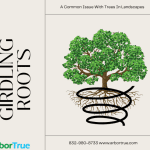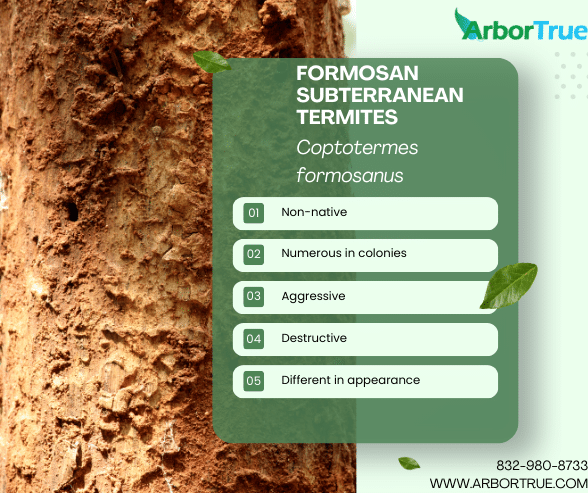
A Common Issue With Trees In Landscapes: Girdling Roots
September 25, 2024
Mushroom Monday: Hexagonia hydnoides
September 30, 2024
Formosan Subterranean Termites (Coptotermes formosanus)
In today’s TrueTreeTalk blog post, we take a look at a nonnative, aggressive, and destructive species, the Formosan Subterranean Termite (Coptotermes formosanus).
Colony size
There can be millions of termites in a Formosan subterranean termite colony. This is in stark contrast to colonies of native termites, which might have hundreds of thousands of termites.
Colonies
Although Formosan subterranean termites are subterranean, they can make nests above ground. They can make these in structures such as homes. Because they can be both under and above ground, they can cause greater damage.
Food
Formosan subterranean termites eat cellulose and the workers are the ones that look for food. They create galleries and tubes of mud as they look for food, and they can go up to three hundred feet down into soil in their search. They can eat dead wood, wood in living trees, plants, and wood in structures. They can also eat things that don’t contain cellulose, such as plastic and plaster, as they look for food. The tunnels they make in wood go with the wood’s grain.
Damage
Formosan subterranean termites can cause extensive damage due to their large numbers. Although an individual termite might eat the same amount of cellulose as a termite of another species, because there are so many more of them, the damage can be greater and happen more quickly.
Formosan subterranean termites can make secondary nests inside of structures called cartons. These are made of feces, chewed up wood, and soil. There can be thousands of termites in them and they serve as a secondary base in their search for food.
Elimination
Because of their numbers, how far away they look for food, and their aggressiveness, it can be extremely difficult for a colony to be eradicated.
Generally, pesticides that are applied on or around structures aren’t sufficient to eliminate colonies because of the large area the termites forage and because of their large numbers. Pesticides that are delayed in their reaction and that are taken back by workers to the colony, may be more effective. Pesticides should only be applied by qualified professionals.
Range
Formosan subterranean termites are non native in the U.S. They arrived here in the 1950s. In the U.S., Formosan subterranean termites can be found in the south, in California, and in Hawaii. They can be spread in things like railroad ties used in landscapes.
Castes
There are three castes of Formosan subterranean termites (as well as other termites). They are the ones that reproduce, the workers, and the soldiers. The reproductive termites include swarmers (alates), kings, queens, and secondary termites that reproduce.
Identification
Worker Formosan subterranean termites look like other termite species. The soldiers and alates however look different and can be useful in identifying them.
The workers are around ⅛ of an inch in length and have a lightish brown/cream color. They have six legs, antennae, and a head, abdomen, and thorax. They are called psuedergates.
The alates are brown/yellow in color and around a half an inch in length. They have wings (2 pairs) with tiny hairs. When they swarm, many fly out at the start of dusk in the spring and summer. They fly toward light and can be found near places like windows and outdoor lights. They might resemble flying ants, however flying ants have wings of different lengths, and the alates have wings that are equal in length. The alates are longer and lighter in color than swarmers of native species. Their fallen wings can be an indication of their presence.
The soldiers have a brown/orange colored head with an oval or drop shape. They have mandibles and their body is whitish. They are around ¼ of an inch in length. If soldiers are disturbed, many can rush out, and they excrete a fluid that is sticky and white. This is from an opening they have on their heads (fontanel). Their head shape can help distinguish them from other termite soldiers which have heads with a rectangle shape. Formosan termite soldiers make up a greater percentage of their colony when compared to native termites (ranging from five to twenty percent vs. one to three percent). Also, native termites don’t excrete the same fluid as Formosan subterranean termites do.
Lifecycle
Generally, alates fly away and lose their wings. They form pairs and the male (king) and female (queen) mate. The female then lays eggs. When the eggs hatch they become larvae. The larvae become either alate nymphs, soldiers, workers, or reproductive termites (with no wings). The reproductive termites lay eggs in the same colony and the alate nymphs develop wings, fly away, and the process repeats.
Indications
There are a number of indicators of termites in general. These include the swarmers, the wings they shed, the tubes they create, and the damage they cause. Above, we noted some ways to distinguish Formosan subterranean termites from other species, but a professional is needed to make an accurate determination.
If you found learning about Formosan subterranean termites informative, check out the other posts on our TrueTreeTalk blog. Follow us on Facebook to keep up with these and other posts.
* * *
ArborTrue is a science-based tree-service company in the greater Houston area. We also serve Austin and other parts of Central Texas. We provide a range of services including tree trimming, tree pruning, tree removal, tree planting, arborist consultations, and more. Call us today at 832-980-8733 (Houston) or at 512-546-3833 (Austin) or reach out to us online to schedule an appointment.




